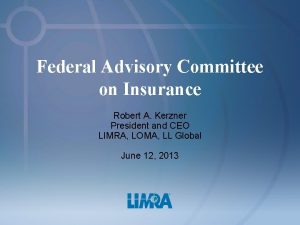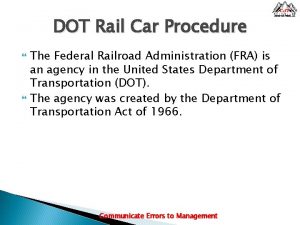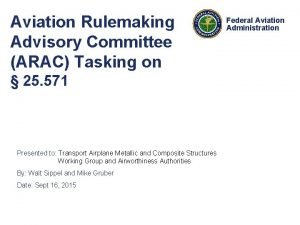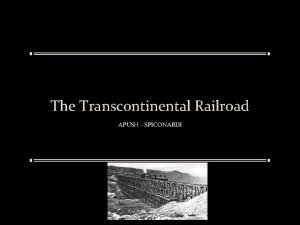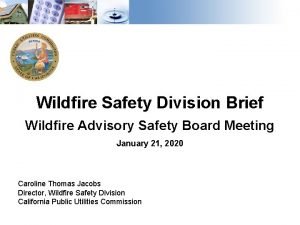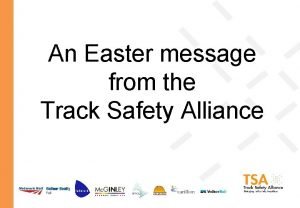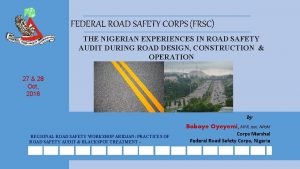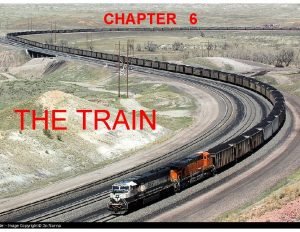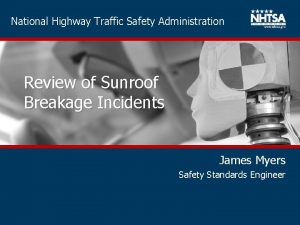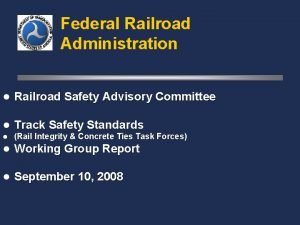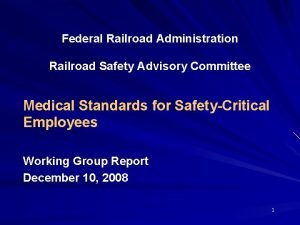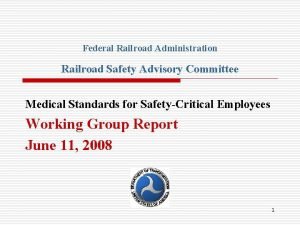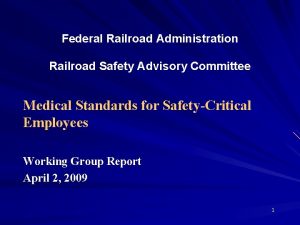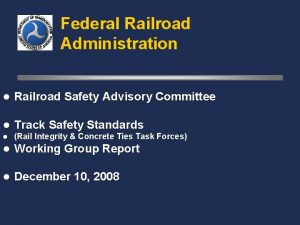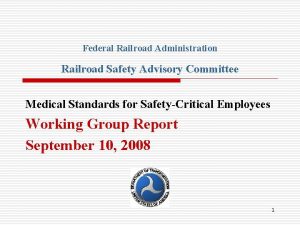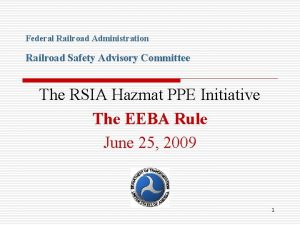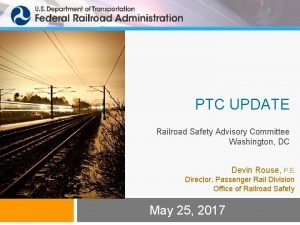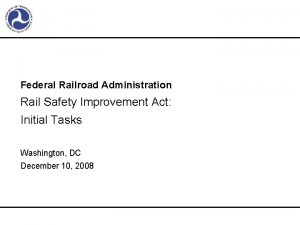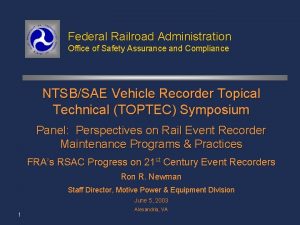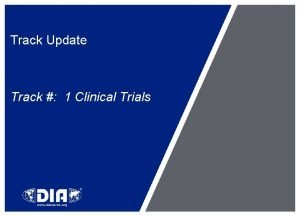Federal Railroad Administration Railroad Safety Advisory Committee Track

















- Slides: 17

Federal Railroad Administration Railroad Safety Advisory Committee Track Safety Standards (Rail Integrity Task Force) Working Group Report April 2, 2009

Track Safety Standards Working Group Rail Integrity Task Force September 10, 2008 - RSAC approved Task 08 -03, assigned to Rail Integrity Task Force: – Factors that can and should be included in determining the frequency of internal rail flaw testing and a methodology for taking those factors into consideration with respect to mandatory testing intervals. – Whether the quality and consistency of internal rail flaw testing can be improved and how. – Whether adjustments to current remedial action criteria are warranted. – The effect of rail head wear, surface conditions and other relevant factors on the acquisition and interpretation of internal rail flaw test results.

Track Safety Standards Working Group Rail Integrity Task Force Last Rail Integrity Task Force Meeting Held on February 3 -4, 2009 in Washington D. C.

Track Safety Standards Working Group Rail Integrity Task Force Task 08 -03 (first item): Factors that can and should be included in determining the frequency of internal rail flaw testing and a methodology for taking those factors into consideration with respect to mandatory testing intervals;

Track Safety Standards Working Group Rail Integrity Task Force Current Regulation § 213. 237 Inspection of rail l (a) In addition to the track inspections required by § 213. 233, a continuous search for internal defects shall be made of all rail in Classes 4 through 5 track, and Class 3 track over which passenger trains operate, at least once every 40 million gross tons (mgt) or once a year, whichever interval is shorter. On Class 3 track over which passenger trains do not operate such a search shall be made at least once every 30 mgt or once a year, whichever interval is longer. ** [This paragraph (a) is effective January 1, 1999. ]

Track Safety Standards Working Group Rail Integrity Task Force Common Criteria Currently Utilized to Determine Test Intervals • • Traffic Density – Tonnage Traffic Risk – Hazmat, Passenger Rail Condition – Type of construction, weight and age of steel, wear/surface condition Detected Defects (Evidence of Rail Fatigue) – # detected defects per mile/per test • Service Failures (Low Inspection Effectiveness) – # service failures per mile/per year • Class of Track – Assigned test frequency to start and increase frequency on statistical change Volpe Center to Develop Model

Track Safety Standards Working Group Rail Integrity Task Force NTSB Recommended Criteria NTSB has recommended a damage tolerance approach that would establish an inspection frequency that allows internal rail defects to be identified before they reach critical size. FRA to consider factors that affect defect growth rate: • • rail head wear accumulated tonnage rail surface conditions track geometry track support steel specifications temperature differentials residual stresses in rail

Track Safety Standards Working Group Rail Integrity Task Force Task 08 -03 (second item): Whether the quality and consistency of internal rail flaw testing can be improved and how;

Track Safety Standards Working Group Rail Integrity Task Force RITF Meeting Discussion FRA Identified Flaw Detection Key Components • System reliability – Properly designed for optimal performance in all rail conditions • Data processing – Intellectual system logic that ensures pattern recognized and insignificant test information is not presented to the operator for interpretation • Operator capability – Training and consistency • Management of test program – Proper test intervals

Track Safety Standards Working Group Rail Integrity Task Force RITF Meeting Discussion – Definition of a qualified operator (first draft completed, FRA will revise for next meeting) – Impact of recently developed technology on inspection effectiveness (Class 1’s do not have sufficient data at this time to present) – RR internal flaw detection procedures and guidelines (recommended practices)

Track Safety Standards Working Group Rail Integrity Task Force Task 08 -03 (third item): Whether adjustments to current remedial action criteria are warranted;

Track Safety Standards Working Group Rail Integrity Task Force Remedial Action Defect Table § 213. 113

Track Safety Standards Working Group Rail Integrity Task Force RITF Meeting Discussion • Should remedial action for known defects vary by class of track? • Based on unpredictable defect growth rate should there be a revision to the remedial actions? • FRA asked for all Class 1’s internal remedial action policy by next meeting date.

Track Safety Standards Working Group Rail Integrity Task Force Task 08 -03 (fourth item): The effect of rail head wear, surface conditions and other relevant factors on the acquisition and interpretation of internal rail flaw test results. ”

Track Safety Standards Working Group Rail Integrity Task Force RITF Meeting Discussion: • How are invalid tests areas determined? (FRA has received RR’s internal policy) • How are invalid test areas monitored/corrected? (Time and tonnage) • Effects of surface condition study? (FRA to consider funding)

Track Safety Standards Working Group Rail Integrity Task Force Open Items: RSAC Task 07 -01 • Review controls applied to reuse of “plug rail” • Ensure a common understanding within the regulated community concerning requirements for internal rail flaw inspections (On hold pending Task 08 -03 results)

Track Safety Standards Working Group Questions?
 Robert kerzner
Robert kerzner Federal railroad administration train car
Federal railroad administration train car Grasshopper sitting on a railroad track lyrics
Grasshopper sitting on a railroad track lyrics Way down south where bananas grow
Way down south where bananas grow Nasa astrophysics advisory committee
Nasa astrophysics advisory committee Conclusion of yashpal committee report
Conclusion of yashpal committee report Trade union advisory committee
Trade union advisory committee Aviation rulemaking advisory committee
Aviation rulemaking advisory committee Transcontinental railroad apush
Transcontinental railroad apush Is federal housing administration relief recovery or reform
Is federal housing administration relief recovery or reform Rsoo
Rsoo Wildfire safety advisory board
Wildfire safety advisory board Track safety alliance
Track safety alliance Functions of federal road safety corps
Functions of federal road safety corps Federal safety appliance act
Federal safety appliance act Closed loop medication administration safety initiative
Closed loop medication administration safety initiative National highway safety administration reviews
National highway safety administration reviews Formation of safety committee
Formation of safety committee
